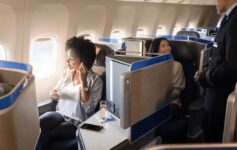It appears that United is finally going to add wi-fi internet access across its domestic fleet and possibly its entire fleet. This announcement, made almost off-handedly by CEO Jeff Smisek earlier today during United’s quarterly conference call, is long overdue. While Delta and American already offer generous internet coverage on large swaths of their domestic fleet, United and Continental have lagged behind.
Continental and LiveTV have been working for years on a solution for Continental aircraft and only recently have come up with a fix using the ViaSat-1 satellite. The legacy United has made a deal with Panasonic, meaning the combined carrier will presumably have two internet providers.
But that is not the point of this post. I am heartened by this news, but the next steps United takes are just as critical. How will internet be priced? Will there be discounts for elites? Will data usage be restricted? Here is my proposal:
1. A monthly fee of $39 – For frequent travelers, this will pay off in no time but still represents a sizeable ancillary revenue to United Airlines. It will be critical that any monthly fee or annual access package (say, $350/year) includes internet access on both United and Continental flights, no matter what the system is. Much like the old Red Carpet Club login system, members could use their frequent flyer numbers and a password to login. It would not be worth the effort to track down people who share usernames and passwords, but the system could prevent the same username from logging on concurrently in more than one place.
2. Consumption based à la carte pricing – Rather than charging based on flight time, United would be wise to charge based on data usage for those who do not purchase the monthly package (which could have two tiers: up to 500MB of data or unlimited). The traveler who simply logs on to the internet to receive incoming e-mail should not pay as much as a traveler streaming Netflix movies onboard or downloading massive files. By tying pricing to date usage, more people would be encouraged to spend a little bit to login and check their e-mail mid-flight and speed would likely be a bit better for everyone as heavy consumption of bandwith would be discouraged.
3. Discount for United Explorer Card holders – Those holding United’s new Chase Visa card should enjoy a discount on internet, similar to the discounts they enjoy on food and beverages purchased onboard.
4. Discount for Mileage Plus elites – A 10% discount for silvers, 20% discount for golds and plats, a 50% discounts for 1Ks, and complimentary service for Global Services would be an industry-leading move that would drive loyalty and get more people to sign-up for monthly and annual packages.
5. Bundle internet with meals/drinks – Offer a “dinner and a movie” package or something of that nature where passengers wavering on whether to purchase meals onboard and pay for internet will end up choosing both by telling themselves they saved $5 by buying the two products together.
6.In-seat Power – While laptop and iPad batteries are getting better, installing standard power ports at each seat will drive internet usuage and also pay-per-view IFE consumption if UA is able to stream IFE in the future.
7. Bring wi-fi to the United Express fleet – Regional jets serve a growing number of markets on United and offering seamless wi-fi on all aircraft bearing United livery would go a long way in improving the “consistently inconsistent” label that most United frequent flyers will agree accurately describes the legacy United.
—
If United adopts these changes I am confident they will become the industry-leader in in-flight internet. They have a lot of ground to make-up, but with a swift roll out and thoughtful pricing, they can please customers like me who are tethered to the internet and even make a nice chunk of change out of it.
And it should be noted that this advice applies equally to all carriers.




I think those are all good ideas, although I think the land-based WiFi service industry (not to mention the mobile phone market) has proven that people are more hesitant to buy pay-by-the-byte Internet service than they are all-you-can-eat service. Along that vein, a more palatable alternative to #2 above would be for people looking for light usage (check email, IM, maybe read the news–but not stream video or do high-bandwidth work) to be offered a flight pass with slower speed and a lower price. For example, get dial-up speed for $1 per flight hour, but broadband for $4 per flight hour. That lets the casual user who just wants to keep an eye on his work email or be available on AIM stay in touch, while the hard-core user needing to connect with Outlook, interact with SharePoint and check files into SVN can pay a premium to get better speeds. Just a thought.
Excellent marketing plan there, Matthew. I plunked down $14.95 for my p.s. flight a week ago and thought to myself there has to be a better way. Love the monthly pass concept, and of course discounts for elites.